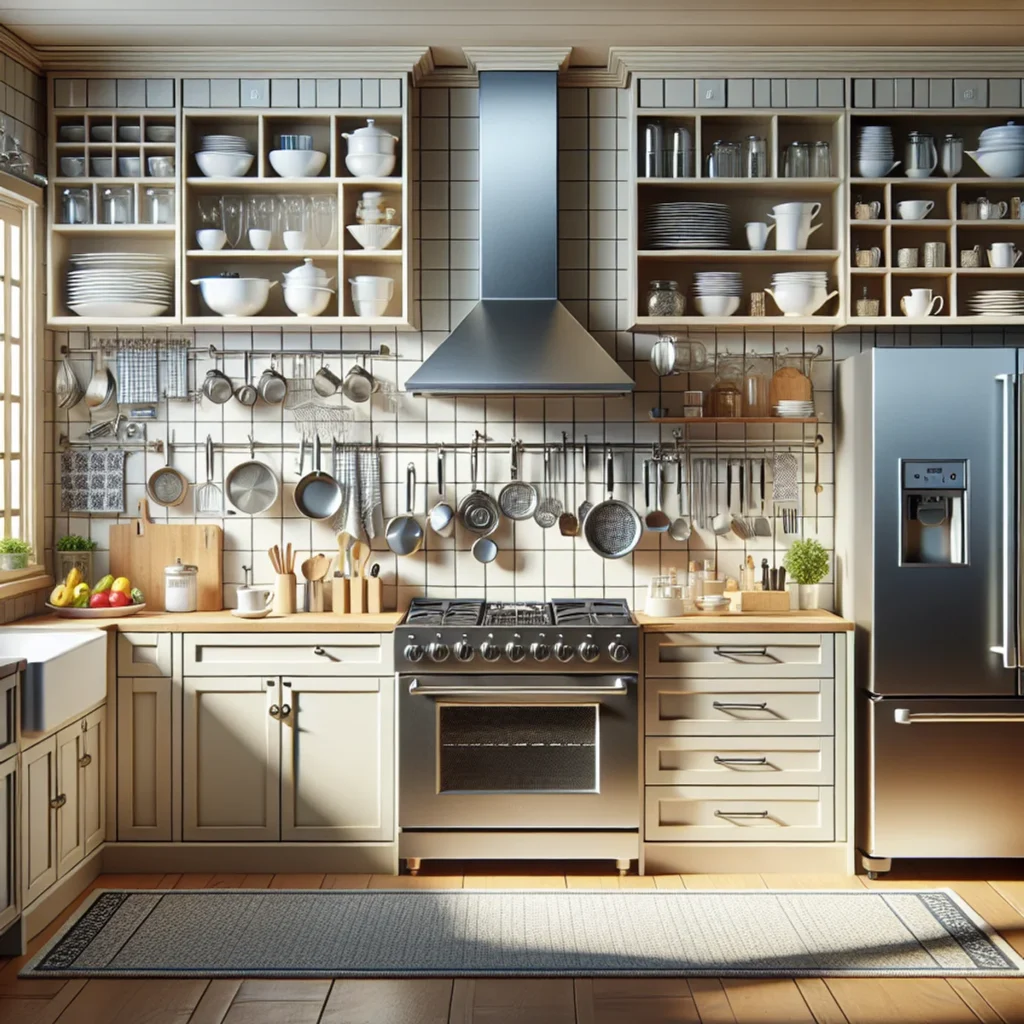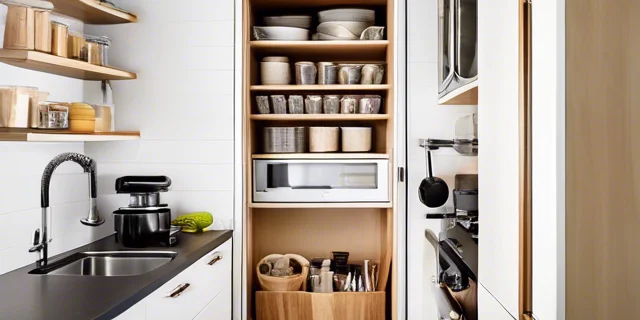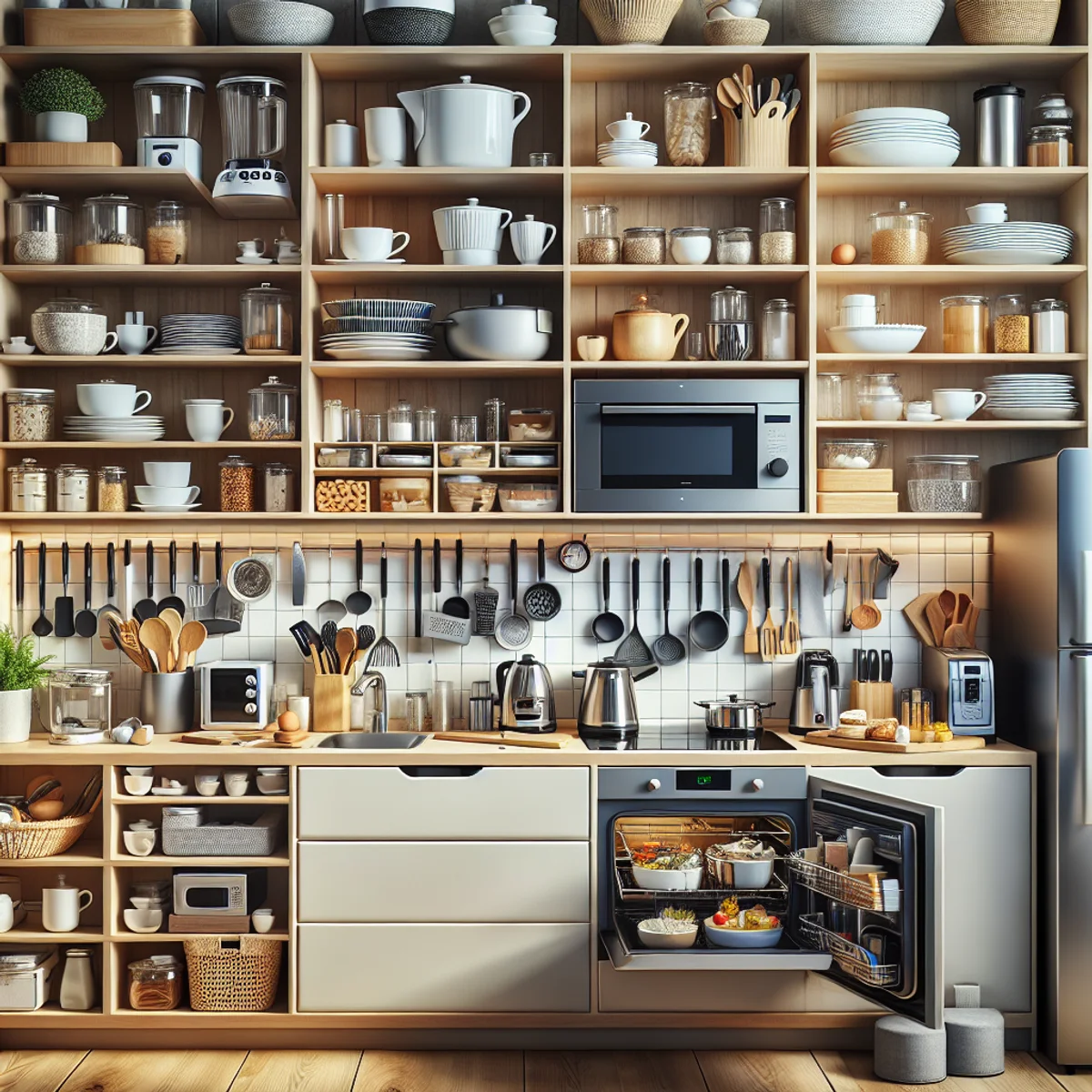As an Amazon Associate I earn from qualifying purchases.
Having a small kitchen presents unique challenges when it comes to fitting in and organizing all the necessary appliances. However, with some strategic planning and clever solutions, you can maximize your compact kitchen layout for both functionality and an uncluttered appearance.
Assessing Your Appliances
The first step is taking stock of what appliances you actually have and determining which ones are essential and which you can do without. Make a list and include key details like the dimensions, frequency of use, any special requirements like venting.
For small kitchens, carefully consider if you can consolidate or eliminate any redundant appliances to free up precious space. Do you really need both a cooker and a multi-cooker that can perform similar functions? Is that single-use appliance like a panini press worth the cabinet real estate? Asking these questions will help pare down to the essential appliances.
Consider which appliances you use on a daily or weekly basis, like the coffee maker, toaster, microwave and blender. Identify the staple appliances that enable you to store, cook and prepare foods for your household on a regular basis. These are the keepers that you’ll want to accommodate conveniently.
Next, look at the specialty or infrequently used appliances. While nice to have, these are lower priority. Can any of your small kitchen workhorses like the Instant Pot also perform those supplementary functions? If you only use the juicer or ice cream maker a few times a year, they are candidates for storage further away or even removal.
Be brutally honest about which appliances simply don’t suit your current lifestyle or kitchen size. Over time we accumulate well-intentioned gifts or impulse purchases that rarely get put to use. Parting with the seldom used panini press, tortilla warmer or egg cooker can give you breathing room. Avoid the temptation to stock up on extra small gadgets just because they’re cute or inexpensive.
Make a habit of reevaluating your appliance needs every couple of years as your household changes. What made sense with a new baby in the house may not work 5 years later. As children grow up, you may not need the specialty appliances for baby food or purees. Similarly, retiring couples no longer cooking for a large family can likely scale down appliance needs.
Evaluating Your Layout

With your appliance list in hand, carefully evaluate the existing layout of your kitchen. Take measurements of the overall kitchen as well as any unusable dead space around pillars, corners or due to awkward cabinet configurations.
Note the placement of doors, windows, outlets, plumbing and other fixed elements you’ll need to work around. This assessment will reveal where you might be able to tuck in appliances creatively, like under the window or repurposing a narrow unused gap between cabinets.
Look for any wasted space that could accommodate appliances, like the area above the cabinets. Double check the clearance requirements for cabinets intended to house appliances to ensure they can safely operate when enclosed. Identify potential problems like cabinets with obstructed openings unable to accommodate appliance sizes or awkward spaces that lack electrical outlets.
Consider the size and placement of kitchen entryways and exits which dictate the traffic flow. Appliances requiring frequent access should be along the main circulation route rather than in cramped dead ends. Areas adjacent to doors leading to dining areas or a home office also tend to be high transit zones.
Don’t neglect evaluating the functionality of existing storage spaces and surfaces intended for appliances. Ensure shelves are actually deep enough for microwave and toaster ovens to sit level. Test if cabinet interiors allow appliances to be inserted and removed comfortably. Assess if countertops are level and of adequate area for typical tasks like food prep.
While it’s tempting to utilize every last bit of space, don’t overlook the importance of sufficient clearance zones. Make sure high traffic pathways have enough room for multiple people to pass through safely. Allow space to fully open appliance doors, drawers and cabinets without collisions.
Maximizing Vertical Storage
One of the best ways to maximize space in a small kitchen is utilizing vertical storage over counters and cabinets. Wall mounted ovens, microwaves or vertical racks open up precious counter surface.
Consider installing extra shelves above cabinets to hold appliances that don’t get everyday use like the juicer, panini press or rice cooker. Over-the-cabinet racks also work beautifully for spices, oils, foil and other kitchen essentials to make them accessible when cooking.
If your kitchen is severely lacking in storage, explore creative vertical solutions like open shelving units added to empty walls. They provide a spot for appliances alongside decorative items for visual appeal. Just be conscious of avoiding a cluttered look by keeping displays pared down.
For upper cabinet storage to work, ensure shelves are safely secured and sturdy enough to bear the weight of appliances. Use non-slip mats to prevent items from shifting or vibrating when opening and closing cabinet doors. Install child safety locks to prevent accidents for households with small children.
Consider installing lift mechanisms for upper cabinets to lower shelves for access to heavy appliances requiring two hands to move. Some mechanisms allow the shelf to be stopped in a partially lowered intermediate position temporarily rather than fully open for quick jobs.
Pay attention to potential safety hazards like cords dangling from above-cabinet appliances that can be tripped over. Use cord organizers and wraps to run lines neatly along the backsplash and minimize hanging loops. Position appliances near outlets to avoid obtrusive cords stretching across countertops.
Organizing by Frequency of Use
When deciding on placement, reserve the most convenient areas within reach for your most frequently used appliances like the coffee maker or toaster. Appliances you use daily should be readily accessible on the counter or in a nearby cabinet.
Reserve the upper and more distant cabinets for those occasional-use specialty appliances that just take up space. This helps keep your prep and cooking workstations free from clutter.
Group the appliances utilized together in the different kitchen zones based on meal preparation workflow. Place pans and pots near the stovetop cooking area. Have food processors and mixers ready to assemble ingredients near the prep station. Stage cleanup tools like the trash can and dish soap dispenser adjacent to the sink.
Think about time of day usage patterns as well. Situate coffee and tea making appliances close at hand for easy access in the mornings. Have appliances needed for whipping up quick family dinners or school lunches handy above the weekday prep area. Reserve the weekend leisure cooking zone for less used gadgets like the juicer or panini maker.
Pay attention to lighting placement to ensure you have ample task lighting over frequently used workstations. Under-cabinet lighting or downlights over key appliances improves visibility for food prep and cooking tasks. Just take care to avoid shadows from overhead cabinets obscuring views for taller users.
Creating Multi-Purpose Stations
Identify ways to consolidate appliances that serve similar purposes, like an organized coffee/tea station or food prep zone. A section of counter housing the coffee maker, kettle and tea canisters means you won’t have to hunt down all the pieces when ready to brew.
A food prep station with the blender, slicer, utensil crock makes assembling ingredients for cooking efficient. Don’t forget the cleanup zone near the sink for the scrub brush, sponge and dish soap.
Consider any dependencies in your workflow that dictate appliance sequence and proximity. Place the toaster near the fridge to allow grabbing spreads or toppings after toasting. Have the coffee grinder or whip cream dispenser close to the coffee machine for seamless workflow.
Pay attention to electrical and outlet needs of appliances when designing stations. Group appliances with high power demands together to avoid tripping breakers. Verify sufficient outlets or use power strips to support plugging in several appliances in one area. Account for required cord length so appliances can connect.
Think about consolidating smaller but frequently used appliances into one organizing tool like a caddy that can be pulled out from under a cabinet. A container holding oil, seasonings, garlic press, cheese grater, can opener and other staples reduces clutter.
For family meal times, consider including space at prep stations to temporarily stage hot dishes coming out of the oven or off the stove top. This facilitates efficient transfer of food to the table or serving platters while freeing up the range.
Optimizing Counter Space

Despite your best efforts, space-hogging appliances still need a home. When not in use, store them in lower corner cabinets or slide them under upper cabinets. Turntables are great for making items in cabinets accessible.
For appliances in frequent rotation, install slide-out trays or shelves in lower cabinets to provide quick access. They make storing and retrieving bulky appliances effortless. Rolling carts are also invaluable for neatly stashing small appliances when not in use to clear counters.
Take a tip from RVs and boats by utilizing every vertical inch. Install racks or cabinets all the way from floor to ceiling. You can find narrow custom cabinets to fit small gaps between existing units or dead corner space. Just be conscious of venting needs.
Get creative repurposing other furniture pieces like dressers, bookshelves or utility carts for small appliance storage and portability. They can often sneak into quirky angled spaces in your kitchen layout. Use height adjustable rolling carts that can duck under overhangs when not needed.
For large appliances like stand mixers that regularly get moved on and off the counter, include dedicated landing spots like a custom sized slide out shelf to corral them. It prevents constantly shuffling other items to make room. Just build in power access.
Don’t overlook cabinet organizational tools like lazy susans, vertical partition racks and pull out drawers as space savers. They make digging appliances out of the back of cabinets much easier. Consider open racks or acrylic organizers to see contents at a glance.
Choosing Smaller Appliances
When upgrading appliances, choose compact sizes that better suit your limited space. Manufacturers now offer smaller microwaves, thinner coffee makers, and combination appliances like the versatile Instant Pot that can replace several gadgets.
Look for versions of essentials like hand mixers designed specifically for small kitchens. Even little changes like selecting a single-cup coffee maker over a 12-cup version can make an impact. If your family doesn’t cook large batches often, consider downsizing large capacity stand mixers and food processors.
There are now mini models of popular appliances like ranges, ovens, dishwashers, and refrigerators scaled down for small homes and apartments. Look into apartment-sized washer/dryers, ice makers and wine coolers tailored for compact spaces.
Be aware that mini and slimline appliances may have limitations, like fewer rack positions or smaller turntables in microwaves. Check that capacity or sizes of mixers, oven chambers or refrigerator shelving still fit your household’s needs before purchasing.
Keep resale value in mind if there’s a possibility you’ll move to a larger home in the future. Opt for standard appliance sizes that retain their appeal to a wider audience of buyers over niche small appliances when possible.
Maintaining Appliances
With kitchen appliances in constant use, preventative maintenance helps avoid disruptive breakdowns or damage that can compromise your setup. Regular cleaning, replacing filters and other care extends appliance lifespan.
Immediately address leaks, dripping water sources or cracks in refrigerator seals to protect cabinetry. Upgrade older, dysfunctional appliances for problem-free performance and energy efficiency.
Over time appliances get moved around and electrical cords can become damaged. Inspect for any frayed cords which are fire and shock hazards. Discard and replace damaged cords. Use cord protectors for high traffic areas to prevent accidental yanking or abrasion.
Monitor appliances for excessive vibration which can cause them to shift during use or excessive noise which may signal upcoming breakdowns. Adjust placement as needed and have repairs done. Vibration pads, non-slip surfaces and proper leveling can help reduce unwanted movement.
Perform manufacturer recommended descaling and grease removal to keep appliances operating effectively. Adequately ventilate appliances producing heat like toasters, microwaves and ovens to prevent damage to cabinetry finishes.
Clean appliances regularly including emptying crumbs from toasters, washing blender jars, wiping grease from oven and range hood filters. Remove dust, dirt and grime to allow appliances to run safely and efficiently. Keeping appliances clean also extends their aesthetic appeal on your countertops.
Safety Considerations

When organizing your small kitchen appliances, keep basic safety guidelines in mind:
- Store heavy appliances on lower shelves and lightweight items up high
- Avoid overloading shelves or outlets with too many appliances
- Leave sufficient clearance zones in front of appliances when open
- Place small appliances away from sink and water sources
- Ensure appliances have heat buffers from flammable materials
- Keep air vents clear and maintain adequate ventilation
- Position cords safely out of high traffic zones
- Use outlet covers and child safety locks when appropriate
- Install appliances as per manufacturer instructions
Making safety a priority when siting appliances will help prevent personal injuries or dangerous situations. Don’t hesitate to bring in professional help to install tricky or heavy appliances overhead or high up.
Reducing Clutter
An overcrowded small kitchen leads to frustration. Reduce visual clutter through careful organization and storage that gets items off counters. Use decorative dividers or screens to conceal appliances.
Group appliances by category, like coffee station or mixers, to reduce scattered look. Arrange items in alignment with cabinet edges instead of random placements. Utilize racks, turntables and risers to neatly organize inside cabinets as well.
Clean up appliance jumbles growing on countertops and rearrange items more intentionally. If appliance collections are looking haphazard, take everything out and start fresh with more methodical placement.
Declutter the space regularly. If appliances like the panini press or ice cream maker haven’t been used in months, remove them to a less prime spot. Donate or sell unused appliances to clear both physical and mental clutter.
Work in phases if a total overhaul feels overwhelming. Start with one area like clearing the counters or organizing one cabinet then build momentum. Maintaining the system is easier once the initial work of creating order is done.
Alternative Storage Spots
If your kitchen cabinets are overflowing, look creatively at alternative storage areas nearby to relocate some appliances. A upright rolling cart tucked in an entryway or hallway can house special occasion appliances.
Check for unused space in the dining room buffet or hutch to rehome appliances. A media console or bookshelf cabinet in a family room may have room on a lower shelf. Consider under stair cubbies, laundry room shelves, coat closets or the garage.
Just be conscious of hazards like exposing appliances vulnerable to moisture to alternate areas like basements or garages. Ensure adequate electrical outlets or extension cords can reach.
For upper level homes, consider installing a dumbwaiter lift near the kitchen to access appliance storage on a lower level. They are compact and eliminate having to carry items up and down stairs repeatedly.
Key Takeaways
The key to effectively organizing appliances in a small kitchen is carefully evaluating your needs, purging non-essentials and creatively utilizing every inch of space vertically and horizontally. Prioritize accessibility for frequently used items and tuck special use appliances out of the way. Embrace multi-purpose stations and smaller gadgets to minimize clutter. With some strategic planning, you can still have a functional, clutter-free kitchen.
As an Amazon Associate I earn from qualifying purchases.

